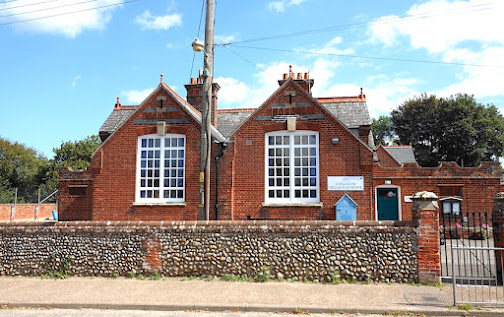A Dame’s School by Thomas George Webster (1800-1886)
In January 1851 a newly built school had been opened in Binham Road, financed by the Reverend Stephen Frost Rippingall of Langham Hall and leased by him to the vicar, the Reverend J M Randall, for a nominal rent. That building is now used as the Village Hall (or Parish Room, if you prefer). A plaque on the south wall reads LANGHAM EPISCOPI NATIONAL SCHOOL 1850, though it was never affiliated to the National Society.
This school served surrounding villages as well as Langham; Stiffkey, Binham and Field Dalling later built their own schools.
The 1870 Act provided for the establishment of School Boards where the education was unsatisfactory or – and this was a cause of some controversy – where parents wanted to remove their children from the influence of the Church. In terms of facilities, ‘Board Schools’ were usually an improvement on many of the Church schools. The Education Department required a minimum of ten square feet for each child and lavatories for boys and girls. The existing school was cramped and the boys had to use the lavatory in a nearby cottage.
There were also a number of non-conformists in the village. The ratepayers held a meeting on 15 December 1893 and resolved to set up a School Board for the United District of Langham, Morston and Cockthorpe. This was an elected body: none of the Langham gentry, though benefactors of the Church school, was elected to this new board.
Board Schools were financed through an Education Rate. The Board purchased a third of an acre on the east side of North Street from Mr John Cain Routh, for £50. A Norwich architect was chosen and tenders invited from builders. A tender of £1,249 was accepted; the Board took out a mortgage for £1,432 with the Royal Liver Friendly Society at 3.5% per annum, and the new building was completed in March 1896.
The Education Act of 1902 provided funds for denominational religious instruction; School Boards were replaced with Local Education Authorities, which in rural areas such as this were the County Councils. Langham School ceased being an all-age school in 1934 and became a County Primary: secondary school pupils had to travel each day to Wells or Fakenham.
_-_A_Dame's_School_-_N00427_-_National_Gallery.jpg)


No comments:
Post a Comment
Please remember to be polite. Any comment with incendiary content will not make it through moderation.